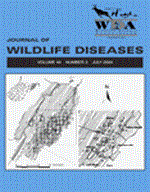Avian vacuolar myelinopathy (AVM) is a neurologic disease primarily affecting bald eagles (Haliaeetus leucocephalus) and American coots (Fulica americana). The disease was first characterized in bald eagles in Arkansas in 1994 and then in American coots in 1996. To date, AVM has been confirmed in six additional avian species. Attempts to identify the etiology of AVM have been unsuccessful to date. The objective of this study was to evaluate dermal and oral routes of exposure of birds to hydrilla (Hydrilla verticillata) and associated materials to evaluate their ability to induce AVM. Mallards (Anas platyrhynchos) were used in all trials; bobwhite quail (Colinus virginianus) also were used in one fresh hydrilla material exposure trial. Five trials were conducted, including two fresh hydrilla material exposure trials, two cyanobacteria exposure trials, and a frozen hydrilla material exposure trial. The cyanobacteria exposure trials and frozen hydrilla material trial involved gavaging mallards with either Pseudanabaena catenata (live culture), Hapalosiphon fontinalis, or frozen hydrilla material with both cyanobacteria species present. With the exception of one fresh hydrilla exposure trial, results were negative or inconclusive. In the 2002 hydrilla material exposure trial, six of nine treated ducks had histologic lesions of AVM. This established the first cause-effect link between aquatic vegetation and AVM and provided evidence supporting an aquatic source for the causal agent.
How to translate text using browser tools
1 July 2004
ESTABLISHING A FOOD-CHAIN LINK BETWEEN AQUATIC PLANT MATERIAL AND AVIAN VACUOLAR MYELINOPATHY IN MALLARDS (ANAS PLATYRHYNCHOS)
Anna H. Birrenkott,
Susan B. Wilde,
John J. Hains,
John R. Fischer,
Thomas M. Murphy,
Charlotte P. Hope,
Pamela G. Parnell,
William W. Bowerman

Journal of Wildlife Diseases
Vol. 40 • No. 3
July 2004
Vol. 40 • No. 3
July 2004
avian vacuolar myelinopathy
Bald Eagle
brain lesion
cyanobacteria
Hydrilla
mallard




